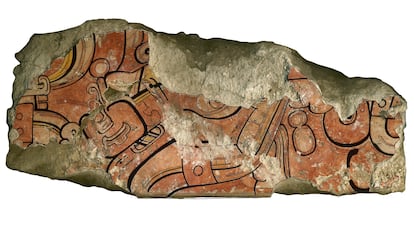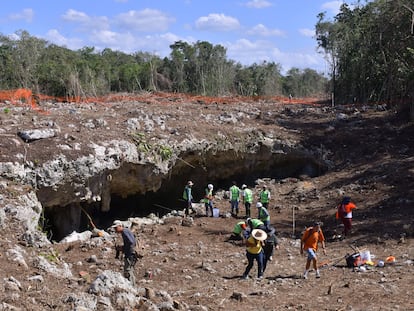Earliest record of the Maya calendar found in the depths of Guatemalan pyramid
Archaeologists identified two plaster fragments depicting a date that the pre-Columbian civilization called ‘7 deer’ and was part of the 260-day calendar cycle
In 2001, a group of archaeologists led by William Saturno discovered a partially concealed Maya city in the jungle of El Petén, in Guatemala. The place known as San Bartolo stood out for its pyramid built in successive phases, one on top of the other. They called it Las Pinturas (”the paintings” in Spanish) after one of the treasures they found inside the first chamber: murals painted in bright colors reminiscent of the frescoes of Roman Pompeii. In between illustrations of their gods and the origin of the world, archaeologists found one of the first samples of the writing of this pre-Columbian civilization. Now, the earliest evidence of the Maya calendar has been identified in two mural fragments found deep within Las Pinturas. The finding shows that the Mayans organized time in a ritual way much earlier than previously believed.
Boris Beltrán was a student at the University of San Carlos in Guatemala City when he joined the San Bartolo excavation team in 2004. Today he is co-director of the San Bartolo-Xultun Regional Archaeological Project and still remembers how, four years later, he found the first reference to the Maya calendar: ”When we found the fragments in the center of the pyramid, we did not realize what they were, but I kept repeating, ‘they are paintings, they are paintings.’” His colleague Heather Hurst, an archaeologist at Skidmore College in the US and co-director of the site, kept saying that “it can’t be, it can’t be”. But it was. There they found more than 7,000 fragments of murals painted on the stucco of the walls. Using radiocarbon dating of charcoal found near the fragments, they were able to calculate that these early paintings would have been etched between 300 and 200 years before our era, some two centuries before the paintings in the first chamber.
“It was the Maya people themselves who knocked down the wall to enlarge the pyramid. But the care with which they dismantled the mural, how they removed the plaster, how they deposited it inside the chamber... It’s as if it were a construction rule of the Maya. When a new structure was made, they buried the old one. It was not just broken and thrown away, it was something sacred, as if they were burying the family,” says Beltrán. “When painting an image, the Maya believed that the act of painting brought the figure to life. So when the end of its useful life came, they had to remove it with respect,“ adds Hurst.
When we found the fragments in the center of the pyramid, we did not realize what they were, but I kept repeating, ‘they are paintings, they are paintings.Boris Beltrán, co-director of the San Bartolo-Xultun Regional Archaeological Project
For more than 10 years, Hurst, Beltrán and other archaeologists including David Stuart, director of the Mesoamerica Center at the University of Texas at Austin, who was involved in the initial discovery, have been trying to solve this puzzle of 7,000 fragments. With the help of sophisticated imaging technologies and their accumulated knowledge about the Maya civilization they managed to recompose scenes that show the origin of the world according to the Maya, of their god of corn or the sun god rising over the mountain. But they have also found glyphs that provide new clues about key aspects of that civilization. One is the first written reference to the governor paired with a figure on a throne in paintings from 100 years before this era, the first evidence of a monarch centuries before the famous kings of Tikal, Ceibal or Palenque. A complex social organization and hierarchy of power already existed.

Among the thousands of fragments there are two that allude to the Tzolk’in, the sacred calendar. Details of these findings have been published in the scientific journal Science Advances. Classified as #4778, one of the pieces shows a dot and a horizontal line. It is missing a piece and there, the researchers maintain, a second point should go. The Maya people wrote the number seven with two dots on top of a line. Between the lower part of this first fragment and the second, the head of a deer can be clearly seen. And “7 deer” is one of the days of the Tzolk’in. Made up of 260 days that are “reminiscent of the length of human gestation,” says Hurst, the almanac has no months. Instead, it is made up of 20 days represented by glyphs and numbered from one to 13 in a cyclical fashion. The date record “7 deer” was followed by “8 star”, “9 jade/water,” “10 dog”, “11 monkey”...
“The Maya had a solar calendar, like us, but they also had a ritual one,” says Hurst. “We also have one, as Easter is part of that sequence of rituals throughout the year,” she adds. It was associated with a creation myth and also to mark the celebrations that accompanied the Haab, the 360-day calendar. The remaining five days, although they were counted, were disastrous and people avoided leaving their homes. Surrounding both was the Calendar Round, which completed its cycle every 52 years. The complex way that the Maya had to organize time was completed with the Long Count, a vigesimal system (base 20) of counting the days linearly. It is with the latter that it has been possible to find equivalencies between the Maya calendar and the Gregorian calendar.
The Maya had a solar calendar, like us, but they also had a ritual one. We also have one, as Easter is part of that sequence of rituals throughout the yearHeather Hurst, co-director of the San Bartolo-Xultun Regional Archaeological Project
The relevance of the discovery of the date record “7 deer” lies in the fact that it would be “the oldest recorded date, in this case on a mural,” according to Beltrán. But they must have been using it for a long time. San Bartolo already existed about 400 years before this era. The very style of the scribes, “so refined” as Hurst points out, suggests a tradition that came from further back. In addition, although the Maya and other Mesoamerican peoples had different ways of organizing power and society, they used the same ritual calendar seen in San Bartolo, a calendar that is still used by indigenous communities today.
For the discoverers of “7 deer,” San Bartolo still has many secrets to reveal. Some are still inside the pyramid, but others are outside. Four roads lead to or leave from the city. “San Bartolo is at the center of something, now we have our eyes on where these roads end,” says Hurst.
Tu suscripción se está usando en otro dispositivo
¿Quieres añadir otro usuario a tu suscripción?
Si continúas leyendo en este dispositivo, no se podrá leer en el otro.
FlechaTu suscripción se está usando en otro dispositivo y solo puedes acceder a EL PAÍS desde un dispositivo a la vez.
Si quieres compartir tu cuenta, cambia tu suscripción a la modalidad Premium, así podrás añadir otro usuario. Cada uno accederá con su propia cuenta de email, lo que os permitirá personalizar vuestra experiencia en EL PAÍS.
¿Tienes una suscripción de empresa? Accede aquí para contratar más cuentas.
En el caso de no saber quién está usando tu cuenta, te recomendamos cambiar tu contraseña aquí.
Si decides continuar compartiendo tu cuenta, este mensaje se mostrará en tu dispositivo y en el de la otra persona que está usando tu cuenta de forma indefinida, afectando a tu experiencia de lectura. Puedes consultar aquí los términos y condiciones de la suscripción digital.
More information
Últimas noticias
Most viewed
- Sinaloa Cartel war is taking its toll on Los Chapitos
- Oona Chaplin: ‘I told James Cameron that I was living in a treehouse and starting a permaculture project with a friend’
- Reinhard Genzel, Nobel laureate in physics: ‘One-minute videos will never give you the truth’
- Why the price of coffee has skyrocketed: from Brazilian plantations to specialty coffee houses
- Silver prices are going crazy: This is what’s fueling the rally










































